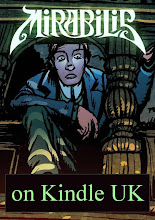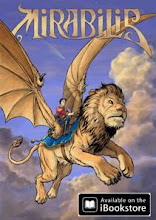 “Above the May Day celebrations in Worplesdon in Surrey, the clouds part and the halls of Olympus can be seen. Down flies an airplane to land on the village green. It’s the Wright brothers, believed lost several months earlier after disappearing into a thick fog off the coast of North Carolina.”
“Above the May Day celebrations in Worplesdon in Surrey, the clouds part and the halls of Olympus can be seen. Down flies an airplane to land on the village green. It’s the Wright brothers, believed lost several months earlier after disappearing into a thick fog off the coast of North Carolina.”That’s how it began: a throwaway paragraph from a big brainstorming document that I did years ago, right after we first came up with the concept of Mirabilis. I put down hundreds of scraps of ideas as they came to me, figuring it was the best way to build up a picture of how fantasy flowed and ebbed through the year.
Each month had a little descriptive line. January: “Some rather queer things have been happening lately.” February: “Did I dream that, or did it really happen?” March: “It’s true; my cousin saw it with his own eyes.” April: “There are new things under the sun.” And so on to November ("Half sick of shadows") to the end.
Fast forward a while. It's 2008. Mirabilis is due to appear in The DFC and Random House have commissioned the Gazetteer for rather a tidy sum. So now Martin and I are working on ideas that would make the twelve full-color spreads that will form the épine dorsale of the Gazetteer – and later, we envisaged, comprise a rather nice Mirabilis calendar.
That first version we weren’t sure about for a couple of reasons. The flying machine was based on a real design by Clément Ader from the 1890s. In real life it didn’t fly, of course, but the green comet effect could change all that. Trouble is, it looks too science fictional, and people would think we were trying to do steampunk. The other problem is the placement of Zeus and Hera, who appear to be montaged in rather than directly interacting with the action. Martin and I mulled over it for days. He wrote:
“I showed it to Dave Carson, who knows about the Mirabilis concept, and he had no idea what we were trying to achieve in the picture, and found it confusing.”
 So, on to the second version. Now Martin has brought the gods into the picture by moving them across and having the line of Zeus’s arm connect with the action below. I wasn’t happy with the flying machine, though. It looked like a real historical Wright Brothers contraption. Snag is, authentic and all, at first glimpse you’d think it was flying backwards. Martin pointed out that was how it would really have flown. But it forces a double-take about the wrong thing. You want your viewer to be going, “Ooh, that plane has flown down to the village green from Olympus!” not, “Have they got that plane the wrong way round or something?”
So, on to the second version. Now Martin has brought the gods into the picture by moving them across and having the line of Zeus’s arm connect with the action below. I wasn’t happy with the flying machine, though. It looked like a real historical Wright Brothers contraption. Snag is, authentic and all, at first glimpse you’d think it was flying backwards. Martin pointed out that was how it would really have flown. But it forces a double-take about the wrong thing. You want your viewer to be going, “Ooh, that plane has flown down to the village green from Olympus!” not, “Have they got that plane the wrong way round or something?”Martin wrote:
“I think the machine we need to use is the Model A Flyer from 1907. It was the fourth machine they designed, the first to feature two seated occupants – a requirement to secure a US Army contract. It was the first to be 'mass' produced, not sure how many but they were also built in Europe – so the truly pioneering vibe of the first three Flyers is slightly lost. But it's the first design where we can show two occupants – except the brothers never flew together, at the request of their father to avoid a double tragedy.”
 And that brings us to the third version. The line of action is much clearer now, and Martin suggested accentuating that by having the suggestion of a “vapor trail” down from Zeus’s hand. It’s also much more dramatic in the way the airplane is buzzing the cricketers. We discovered that Zeus’s many epithets included Phyxius, god of flight, so it’s reasonable that he might take an interest in Orville and Wilbur’s experiments. (He was also sometimes known as Terminalis, protector of boundaries, which explains why he would be observing a village cricket match.)
And that brings us to the third version. The line of action is much clearer now, and Martin suggested accentuating that by having the suggestion of a “vapor trail” down from Zeus’s hand. It’s also much more dramatic in the way the airplane is buzzing the cricketers. We discovered that Zeus’s many epithets included Phyxius, god of flight, so it’s reasonable that he might take an interest in Orville and Wilbur’s experiments. (He was also sometimes known as Terminalis, protector of boundaries, which explains why he would be observing a village cricket match.)We were still not completely satisfied with the picture, and I suspect by this time that Martin was coming to the conclusion that it would work better if he chose what to illustrate, rather than have me foist impossibly complicated compositions on him!
In the end, the concept changed anyway. I felt that Worplesdon was getting enough coverage in Mirabilis (the Sidney Sime connection, you see) and we needed to show more episodes from around the world – specifically, from other parts of the Empire, to show the global transformation of the Edwardian era that Comet Meadowvane was causing. Hence the report to the Royal Mythological Society moved the whole thing over to India:
Dear Professor Bromfield and Doctor Clattercut
An extraordinary event took place during a recent cricket match between the royal court and the local British regiment. The court was 150 for 4 when a great rock slid like a cloud across the sky, and down from it came a buzzing machine made of wire, wood and brown paper.
The contraption landed in the middle of the pitch, driving two deep ruts right across from mid-wicket to the stumps despite the hardness of the ground at the time of year. I barely threw myself out of the way in time, after first giving the propeller a sound clout with my bat, whereupon a young fellow wearing a leather hat and goggles leapt out crying, “For Pete’s sake, mister, why’d you have to go do a thing like that?”
When my temper cooled a little, I discovered the two occupants of this aerial machine were brothers by the name of Wright. Having taken off from a field in North Carolina back in January, they flew into a storm and were forced to land on what they thought was Bermuda, but which turned out in fact to be the flying island of Laputa. The island was carried around the world by the trade winds, and by chance the brothers Wright had completed repairs on their vehicle and were ready to take off again just as they passed over our pitch.
The question is, would you say this occurrence is ground for abandoning the whole game, or did the court (as the umpires ruled) forfeit the match? We cannot resume play now because the monsoon has arrived.
Very truly yours, Prince Duleep Singh,
Lahore
Dr Clattercut replies: Please do not treat the brothers Wright too harshly, your royal highness. Americans don’t understand cricket and so they probably think they've done nothing worse than if they had disrupted a game of baseball.
Prof Bromfield: Yes, and in any case the harm is done. The umpires have the last word, no doubt about it. You’ll get nowhere arguing with them, any more than with the Fates.
Dr Clattercut: It is the Graeae, of course - the three “grey sisters” of Greek myth - who share but a single eye between them.























Lovely, lovely stuff Dave. I'm always in awe of Martin's work and seeing his working drawings like this is akin to the delight of seeing animation pencil tests from classic Disney cartoons, or Leonardo's sketches.
ReplyDeletePresumably you mean Leonardo *Hartas*, Peter? I'm glad you enjoyed the post - I promised it to you a while back but it was a lot more complicated than I thought as I had to unearth Martin's and my emails and research from two years ago. Good job I'm a hoarder!
ReplyDeleteDohhhhh!!!
ReplyDeleteWell Dave, if you will insist on utilizing the resources of two such illustration wunderkinds, but the drawings are so definitely Leo's work that I'm amazed that I got it so wrong.
Further dohhhhhhhhhhh!!!
Well, Peter, next up I will find some of Leo's working drawings. Faced with the task of producing a cover painting for the second volume of the Winter book, we realized we needed something in keeping with the style of Martin's Jack pin-up - the only snag being that Martin is madly busy on his lovely kids' book The Light That Went Out. So Leo did a truly mouth-watering painting of Estelle in a sort of homage to Martin's style. I'm keeping it under wraps just until we have a firm release date for those two volumes - but I think you'll be amazed.
ReplyDelete